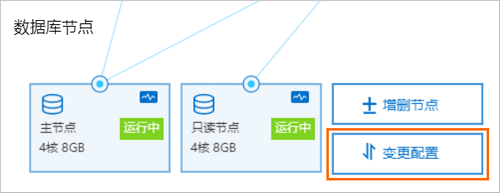臨時升配是指臨時升級規格,您可以對整個叢集進行規格升級,也可對叢集中的單個節點進行規格升級。到達指定的還原時間後,叢集的規格會自動還原到臨時升配前的狀態。PolarDB的訂用帳戶叢集支援臨時升配,可以協助您輕鬆應對短時間的業務高峰期。
前提條件
叢集為訂用帳戶叢集。
叢集沒有尚未生效的續約變更配置訂單和臨時升配訂單。
注意事項
不支援臨時降配操作。
臨時升配過程和還原過程可能會出現閃斷,請確保應用程式具備重連機制。
臨時升配時間與您叢集的資料量相關。
還原時間不能晚於叢集到期時間的前1天。例如,叢集1月10日到期,則臨時升配的還原時間最多為1月9日。
臨時升配期間不支援自動變更配置、增加或刪除節點。如有需求,請將臨時升配轉為永久升配。
臨時升配期間(叢集狀態為運行中)支援手動升配,具體操作請參見手動變更配置。
臨時升配的最短時間為1小時,建議升配時間最長不超過14天。
臨時升配後如果效能不夠或需要延長還原時間,可以在還原時間到達之前最多再進行1次升配,此次設定的還原時間不能早於第1次。
臨時升配期間叢集不支援退訂。
臨時升配轉為永久升配
如果您需要保持臨時升配後的規格,在臨時升配期間(叢集狀態為運行中),可以選擇將臨時升配轉為永久升配(即還原時間點後不會自動降配)。具體操作方式為:在升配頁面通過手動升配,選擇將叢集升配到當前的規格。
該操作對您的業務不會造成任何影響。
在臨時升配期間,若對叢集執行了儲存空間擴容操作,同樣會將臨時升配轉為永久升配。
主節點和唯讀節點可單獨變更配置規格
PolarDB叢集支援對主節點和唯讀節點分別臨時升級規格,即唯讀節點的規格可以與主節點規格不一致。
使用限制
同一叢集中,確保至少有一個唯讀節點與主節點規格保持一致。
唯讀節點規格建議不要與主節點規格相差過大:
唯讀節點的記憶體不能小於主節點記憶體的一半。
唯讀節點的CPU規格與主節點CPU規格對應規則如下:
主節點CPU規格(core)
允許唯讀節點最小CPU規格(core)
2
2
4
4
8
4
16
8
32
16
64
32
88
32
開啟熱備後的唯讀節點需要與主節點規格保持一致。
唯讀列存節點情境下建議唯讀列存節點規格比主節點規格更高。
PolarDB多主叢集(庫表)不受以上使用限制。
計費
臨時升配的價格是新老配置價差的1.5倍。計算公式如下:
臨時升配N天,費用 =(新規格包月價格 - 老規格包月價格)/30 x 1.5 x N。
操作步驟
登入PolarDB控制台。
在左側導覽列單擊叢集列表。
在左上方,選擇叢集所在地區。
在集群列表頁,找到目的地組群。
您可以選擇如下兩種方式中的其中一種進入变更配置(包年包月)頁面:
單擊目的地組群操作欄中的变更配置。

單擊目的地組群ID,進入目的地組群基本信息頁。在数据库节点地區,單擊变更配置。

在彈出的变更配置(包年包月)頁面,選中临时升配,單擊确定。
說明僅訂用帳戶叢集支援临时升配。
在彈出的頁面中,設定如下參數。
參數
說明
子系列
為叢集選擇升級後的目標子系列,包括通用规格和独享规格。
節點
為當前節點選擇升級後的目標節點規格。
說明確保一個唯讀節點與主節點規格保持一致,其他節點規格均可選擇配置。
還原時間
選擇短時升配的到期還原時間。
說明臨時升配後如果效能不夠,在還原時間到達之前最多可以再進行1次升配,此次設定的還原時間不能早於第1次。
臨時升配的最短時間為1小時,由於設定還原時間後無法修改,建議升配時間為14天以內。
還原時間不能晚於叢集到期時間的前一天。
選中服務合約,單擊立即購買完成支付。
在支付頁面,確認待支付訂單,單擊支付。